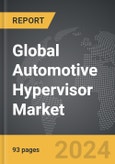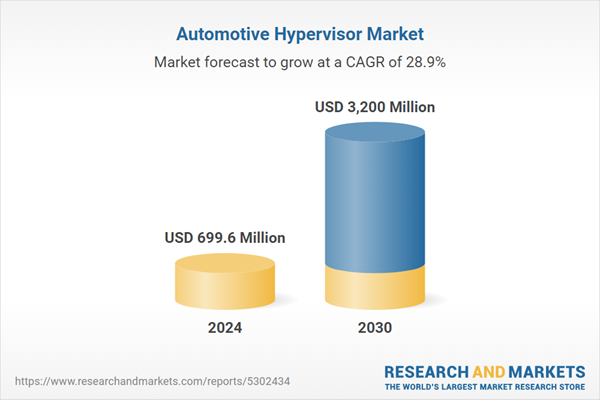Global Automotive Hypervisor Market - Key Trends and Drivers Summarized
Why Is the Automotive Hypervisor Crucial for Modern Vehicle Architecture?
Automotive hypervisors have become essential in modern vehicles, enabling the integration of multiple, often complex, software systems within a single electronic control unit (ECU). As vehicle electronics have advanced, automakers are increasingly incorporating diverse software applications - from infotainment and advanced driver-assistance systems (ADAS) to critical safety functions - that require isolated yet interconnected computing environments. The hypervisor creates a virtualized platform that allows multiple operating systems to run on the same hardware, partitioning resources to ensure that safety-critical systems operate independently from non-critical applications. This capability is particularly valuable in ensuring that a failure in one system, such as the infotainment, does not impact the functioning of essential safety features like braking or steering assistance. Automotive hypervisors are central to the development of next-generation connected and autonomous vehicles, as they support high levels of integration without compromising reliability or performance. By consolidating hardware and enabling secure multi-environment functionality, hypervisors simplify the vehicle's electronic architecture, reduce costs, and improve efficiency, making them indispensable for modern automotive systems.How Are Technological Advancements Driving the Evolution of Automotive Hypervisors?
Technological advancements in virtualization, processor performance, and cybersecurity are driving rapid improvements in automotive hypervisors, making them more efficient, secure, and capable of handling the increasing complexity of vehicle software. Traditional Type 1 hypervisors, which run directly on hardware, have been optimized to provide real-time processing for critical applications, essential for maintaining responsiveness in systems like ADAS. Modern hypervisors now leverage multi-core processors, allowing them to allocate dedicated cores to specific applications, ensuring that each function, whether it's ADAS or infotainment, receives the resources it needs without interference. Additionally, advanced hypervisors are designed with robust fault isolation and real-time security monitoring to prevent cyber threats, ensuring that even if one application is compromised, it does not impact other critical functions. These hypervisors often use virtual machine (VM) configurations that are specifically hardened to meet stringent automotive safety standards like ISO 26262. Moreover, software-defined architectures have enabled adaptive resource allocation, where hypervisors can dynamically reallocate resources based on demand, such as prioritizing ADAS functions over entertainment in high-stress driving scenarios. These advancements are making automotive hypervisors more agile, secure, and capable of managing the diverse requirements of connected and autonomous vehicles, as they bring a new level of adaptability and resilience to vehicle computing systems.What Role Do Automotive Hypervisors Play in Enhancing Vehicle Safety and Security?
Automotive hypervisors play a pivotal role in enhancing vehicle safety and cybersecurity by creating isolated environments for different applications, ensuring that critical systems can operate securely and independently. In traditional vehicle electronics, all functions often run on separate ECUs, which can be complex and costly to manage; hypervisors allow multiple functions to be consolidated onto a single ECU, with each function operating in a virtual machine. This partitioning is crucial for safety, as it ensures that essential systems - such as braking, steering, and airbag deployment - are isolated from non-essential functions like infotainment. In the event of a fault or a security breach in one virtual machine, the hypervisor prevents that issue from spreading, maintaining the integrity of other critical systems. Additionally, hypervisors support cybersecurity features by enabling secure boot processes, runtime monitoring, and intrusion detection within each virtual environment. In autonomous and connected vehicles, where cyber threats are a major concern, hypervisors allow for real-time security updates and the containment of potential threats without interrupting essential vehicle operations. By protecting both the vehicle's internal systems and its connectivity features, automotive hypervisors create a secure, resilient foundation that is vital for the safe operation of modern, software-driven vehicles.What Is Driving the Growth in the Automotive Hypervisor Market?
The growth in the automotive hypervisor market is driven by the increasing complexity of in-vehicle systems, the rise of connected and autonomous vehicles, and the automotive industry's push toward cost and hardware consolidation. As automakers introduce more software-driven features, including advanced infotainment, ADAS, and vehicle-to-everything (V2X) communication, there is a pressing need to run multiple operating systems and applications on fewer physical units. Hypervisors allow manufacturers to consolidate ECUs by running multiple virtualized environments on a single hardware platform, which reduces weight, power consumption, and manufacturing costs, all of which are critical for achieving fuel efficiency and extended battery life in electric vehicles. Additionally, the move toward autonomous driving has significantly increased the need for secure and isolated computing environments, as autonomous systems demand rapid, reliable processing of sensor data and decision-making algorithms alongside traditional vehicle control functions. Regulatory demands for cybersecurity and functional safety, particularly with standards like ISO 26262, are also encouraging automakers to adopt hypervisors that meet these requirements by providing fault isolation and secure, real-time updates. Furthermore, consumers' growing expectations for seamless, technology-enhanced driving experiences are pushing manufacturers to create integrated, adaptable electronic systems that support frequent updates and connectivity. These trends are accelerating the adoption of automotive hypervisors, making them a cornerstone in the development of secure, efficient, and future-ready automotive electronics.Report Scope
The report analyzes the Automotive Hypervisor market, presented in terms of market value (US$ Thousand). The analysis covers the key segments and geographic regions outlined below.- Segments: Level of Automation (Semi-Autonomous, Fully Autonomous); Vehicle Class (Luxury, Mid-priced, Economy); End-Use (Passenger Cars, Light Commercial Vehicles, Heavy Commercial Vehicles).
- Geographic Regions/Countries:World; United States; Canada; Japan; China; Europe (France; Germany; Italy; United Kingdom; and Rest of Europe); Asia-Pacific; Rest of World.
Why You Should Buy This Report:
- Detailed Market Analysis: Access a thorough analysis of the Global Automotive Hypervisor Market, covering all major geographic regions and market segments.
- Competitive Insights: Get an overview of the competitive landscape, including the market presence of major players across different geographies.
- Future Trends and Drivers: Understand the key trends and drivers shaping the future of the Global Automotive Hypervisor Market.
- Actionable Insights: Benefit from actionable insights that can help you identify new revenue opportunities and make strategic business decisions.
Key Questions Answered:
- How is the Global Automotive Hypervisor Market expected to evolve by 2030?
- What are the main drivers and restraints affecting the market?
- Which market segments will grow the most over the forecast period?
- How will market shares for different regions and segments change by 2030?
- Who are the leading players in the market, and what are their prospects?
Report Features:
- Comprehensive Market Data: Independent analysis of annual sales and market forecasts in US$ Million from 2024 to 2030.
- In-Depth Regional Analysis: Detailed insights into key markets, including the U.S., China, Japan, Canada, Europe, Asia-Pacific, Latin America, Middle East, and Africa.
- Company Profiles: Coverage of players such as Bitdefender, Blackberry, Continental, Denso, Green Hills Software and more.
- Complimentary Updates: Receive free report updates for one year to keep you informed of the latest market developments.
Some of the 41 companies featured in this Automotive Hypervisor market report include:
- Bitdefender
- Blackberry
- Continental
- Denso
- Green Hills Software
- Hangsheng Technology
- Harman
- IBM
- Kpit
- Luxoft
This edition integrates the latest global trade and economic shifts into comprehensive market analysis. Key updates include:
- Tariff and Trade Impact: Insights into global tariff negotiations across 180+ countries, with analysis of supply chain turbulence, sourcing disruptions, and geographic realignment. Special focus on 2025 as a pivotal year for trade tensions, including updated perspectives on the Trump-era tariffs.
- Adjusted Forecasts and Analytics: Revised global and regional market forecasts through 2030, incorporating tariff effects, economic uncertainty, and structural changes in globalization. Includes historical analysis from 2015 to 2023.
- Strategic Market Dynamics: Evaluation of revised market prospects, regional outlooks, and key economic indicators such as population and urbanization trends.
- Innovation & Technology Trends: Latest developments in product and process innovation, emerging technologies, and key industry drivers shaping the competitive landscape.
- Competitive Intelligence: Updated global market share estimates for 2025, competitive positioning of major players (Strong/Active/Niche/Trivial), and refined focus on leading global brands and core players.
- Expert Insight & Commentary: Strategic analysis from economists, trade experts, and domain specialists to contextualize market shifts and identify emerging opportunities.
Table of Contents
Companies Mentioned (Partial List)
A selection of companies mentioned in this report includes, but is not limited to:
- Bitdefender
- Blackberry
- Continental
- Denso
- Green Hills Software
- Hangsheng Technology
- Harman
- IBM
- Kpit
- Luxoft
Table Information
| Report Attribute | Details |
|---|---|
| No. of Pages | 171 |
| Published | December 2025 |
| Forecast Period | 2024 - 2030 |
| Estimated Market Value ( USD | $ 699.6 Million |
| Forecasted Market Value ( USD | $ 3200 Million |
| Compound Annual Growth Rate | 28.9% |
| Regions Covered | Global |









